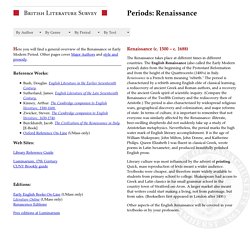

English Renaissance Literature. In a Nutshell Ch-ch-changes… Changes were happening all day, every day in 15th-to-17th-century Europe.

Don't take those old movies about this era at face value, though; they might give you the impression that the Renaissance was all tights, puffy sleeves, and feathered hats. There was a lot more to the Renaissance than that. This cultural rebirth began in Italy, just after a particularly rough period in Europe's history. No, we're not in the camp that thinks the Middle Ages had nothing to offer but doom-and-gloom. Just think about that for a second. Yikes. After those old Europeans found a way to deal with this awful new disease—quarantine the sick—people had more time to farm.
And then printing presses made literature available to the masses, and church services were no longer given in inaccessible Latin. In fact, the church itself changed quite radically during that time period. And everything was different. He was also put under house arrest. And that really freaked people out. Renaissance Period. Renaissance (c. 1500 – c. 1688) The Renaissance takes place at different times in different countries.

The English Renaissance (also called the Early Modern period) dates from the beginning of the Protestant Reformation and from the height of the Quattrocento (1400's) in Italy. Renaissance is a French term meaning "rebirth. " The period is characterized by a rebirth among English elite of classical learning, a rediscovery of ancient Greek and Roman authors, and a recovery of the ancient Greek spirit of scientific inquiry. (Compare the Renaissance of the Twelfth Century and the rediscovery then of Aristotle.) Literary culture was most influenced by the advent of printing.
Other aspects of the English Renaissance will be covered in your textbooks or by your professors. History of the Renaissance in Europe: A rebirth, renewal, rediscovery. The Renaissance Beginning And Progress Of The Renaissance Edited By: R. A. Guisepi Fourteenth To Sixteenth Century Not what man knows but what man feels, concerns art. European history. Courtly Love in the Middle Ages: Definition, Characteristics & Rules. Explore this lesson on courtly love, an essential concept to understanding relationships between men and women in medieval literature.

Learn the definition of courtly love, its connection with chivalry, the rules of courtly love, and discover examples of works that feature courtly love from the middle ages. Explore our library of over 10,000 lessons Click "next lesson" whenever you finish a lesson and quiz. Got It You now have full access to our lessons and courses. You're 25% of the way through this course! Way to go! Congratulations on earning a badge for watching 10 videos but you've only scratched the surface. You've just earned a badge for watching 50 different lessons. You have earned a badge for watching 20 minutes of lessons. You have earned a badge for watching 50 minutes of lessons. You have earned a badge for watching 100 minutes of lessons. You have earned a badge for watching 250 minutes of lessons. You have earned a badge for watching 500 minutes of lessons.
Courtly Love - World History in Context. One of the most commonly held, and perhaps most misunderstood, modern notions about the Middle Ages is the type of romantic or erotic love believed to have been practiced in the period, popularly referred to as "courtly love.

" Courtly love is a cluster of related ideas and sensibilities characterizing an extreme expression of romantic passion that was demonstrated frequently by characters in medieval literature, especially in courtly romances and the love lyrics of the French troubadours and the German minnesingers. The term "courtly love" was never used in medieval texts, although medieval authors and poets did use the term fin'amors (refined love) to describe the extremes of emotion experienced, often suffered, by male protagonists in romances and by the lover singing love songs to his beloved in the lyric tradition. But what exactly was the late medieval European phenomenon known popularly as "courtly love"? The knights and ladies at the aristocratic courts.